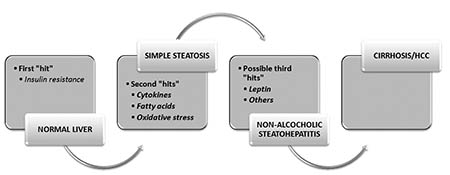
A Bird's Eye View of Non Alcoholic Fatty Liver Disease - an Insulin Resistant State
Abstract
Nonalcoholic fatty liver disease (NAFLD) is an increasingly recognized form of chronic liver disease. It encompasses a spectrum of conditions associated with lipid deposition in hepatocytes. It ranges from steatosis (simple fatty liver), to nonalcoholic steatohepatitis (NASH—fatty changes with inflammation and hepatocellular injury or fibrosis), to advanced fibrosis and cirrhosis. Studies have suggested that although simple fatty liver is a benign condition, NASH may progress to fibrosis and lead to end-stage liver disease. The disease is mostly silent and often discovered through incidentally elevated liver enzyme levels. It is strongly associated with obesity and insulin resistance and is currently considered by many as the hepatic component of the metabolic syndrome. NASH cirrhosis is now one of the leading indications for liver transplantation particularly in the United States. As NAFLD is considered to be one of the insulin resistant states like Type 2 Diabetes Mellitus (T2M) a brief understanding of the disease is essential in regions where obesity and T2M are prevalent in the majority of the population. Therefore the present review outlines the salient features of NAFLD.
Keywords
Steatosis; steatohepatitis; Nonalcoholic fatty liver disease(NAFLD); Non alcoholic steatohepatitis (NASH); Insulin resistance; Type 2 Diabetes Mellitus
DOI: 10.5457/ams.v39i1.153
